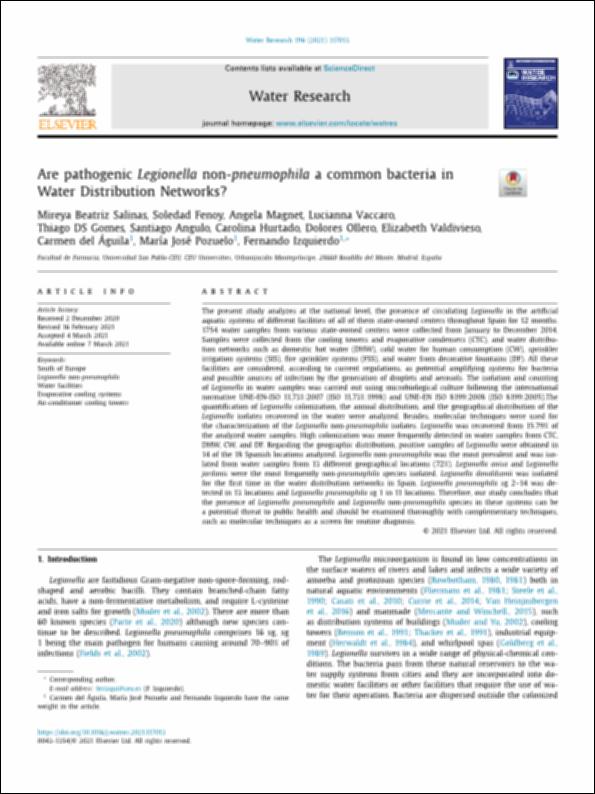Por favor, use este identificador para citar o enlazar este ítem:
http://hdl.handle.net/10637/15034Are pathogenic Legionella non-pneumophila a common bacteria in Water Distribution Networks?

Ver/Abrir:
Pathogenic_Salinas_et_al_Water_Res_2021.pdf
Acceso restringido
1,4 MB
Adobe PDF
Request a copy
| Título : | Are pathogenic Legionella non-pneumophila a common bacteria in Water Distribution Networks? |
| Autor : | Salinas Granell, Mireya Beatriz Fenoy Rodríguez, Soledad Magnet, Angela Vaccaro Muñoz, Lucianna Rosalía Gomes, Thiago Santos Hurtado Marcos, Carolina Ollero Baceiredo, Dolores Valdivieso Blanco, Elizabeth Águila de la Puente, Carmen del Pozuelo de Felipe, María José Izquierdo Arias, Fernando |
| Materias: | Air-conditioner cooling towers; Evaporative cooling systems; Legionella non-pneumophila; South of Europe; Water facilities |
| Editorial : | Elsevier |
| Citación : | Salinas MB, Fenoy S, Magnet A, Vaccaro L, Gomes TD, Hurtado C, Ollero D, Valdivieso E, Del Águila C, Pozuelo MJ, Izquierdo F. Are pathogenic Legionella non-pneumophila a common bacteria in Water Distribution Networks? Water Res. 2021 May 15;196:117013. doi: 10.1016/j.watres.2021.117013. |
| Resumen : | The present study analyzes at the national level, the presence of circulating Legionella in the artificial aquatic systems of different facilities of all of them state-owned centers throughout Spain for 12 months. 1754 water samples from various state-owned centers were collected from January to December 2014. Samples were collected from the cooling towers and evaporative condensers (CTC), and water distribution networks such as domestic hot water (DHW), cold water for human consumption (CW), sprinkler irrigation systems (SIS), fire sprinkler systems (FSS), and water from decorative fountains (DF). All these facilities are considered, according to current regulations, as potential amplifying systems for bacteria and possible sources of infection by the generation of droplets and aerosols. The isolation and counting of Legionella in water samples was carried out using microbiological culture following the international normative UNE-EN-ISO 11,731:2007 (ISO 11,731:1998) and UNE-EN ISO 8199:2008 (ISO 8199:2005).The quantification of Legionella colonization, the annual distribution, and the geographical distribution of the Legionella isolates recovered in the water were analyzed. Besides, molecular techniques were used for the characterization of the Legionella non-pneumophila isolates. Legionella was recovered from 15.79% of the analyzed water samples. High colonization was more frequently detected in water samples from CTC, DHW, CW, and DF. Regarding the geographic distribution, positive samples of Legionella were obtained in 14 of the 18 Spanish locations analyzed. Legionella non-pneumophila was the most prevalent and was isolated from water samples from 13 different geographical locations (72%). Legionella anisa and Legionella jordanis were the most frequently non-pneumophila species isolated. Legionella donaldsonii was isolated for the first time in the water distribution networks in Spain. Legionella pneumophila sg 2-14 was detected in 13 locations and Legionella pneumophila sg 1 in 11 locations. Therefore, our study concludes that the presence of Legionella pneumophila and Legionella non-pneumophila species in these systems can be a potential threat to public health and should be examined thoroughly with complementary techniques, such as molecular techniques as a screen for routine diagnosis. |
| Descripción : | Acceso al texto completo en la siguiente URL de la revista: https://www.sciencedirect.com/journal/water-research/vol/196/suppl/C |
| URI : | http://hdl.handle.net/10637/15034 |
| ISSN : | 0043-1354 |
| Fecha de publicación : | 7-mar-2021 |
| Centro : | Universidad San Pablo-CEU |
| Aparece en las colecciones: | Facultad de Farmacia |
Los ítems de DSpace están protegidos por copyright, con todos los derechos reservados, a menos que se indique lo contrario.

